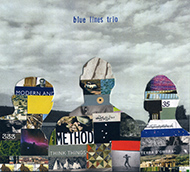Blue Lines Trio
Blue Lines Trio
(Casco Records)
A
fine album, which I found - completely out of the blue - waiting for me in my
mailbox. It got here at the right moment, too, one of those days when one
almost starts believing that by now all good music is only to be found in the
past, and that the time has come to listen to those old records all over again.
A
fine album, mind you, not a masterpiece or this year's Change Of The Century.
But an album that will keep one interested for its duration, and that - though
it can be said it moves inside a framework that's definitely familiar - will
offer listeners some unfamiliar moments.
"What
framework?", I hear you say. Well, if I say "jazz piano trio" I
know I'll run the risk of raising expectations that can't be met, on one hand,
and provoking uninterestedness, on the other. I'll just say that here the great
heritage of US jazz gets cooked in Dutch sauce, and leave it at that, hoping
the rest will become clearer when I discuss the pieces in detail, below.
The
line-up features Michiel Scheen on piano; Raoul van der Weide on double bass,
crackle box, and "sounding objects"; and George Hadow on drums.
Looking at the picture that appears inside the CD cover, the drummer looks in
his early thirties, while the piano player looks in his late forties, and the
bass player looks in his late fifties. At first I thought I was unfamiliar with
all three, but on impulse I had a look at some old CDs I own by Dutch double
bass player and composer Maarten Altena released in the late eighties/early
nineties (Quotl, Cities And Streets, and Code), and here he was: Michiel
Scheen, looking quite young indeed.
The
trio has a fine sound, the piano often played in the middle part of the
keyboard, the bass work almost never to the fore but never sounding banal, the
drums inevitably reminding me of Han Bennink (only when it comes to the sound
of the instrument, not its role in the music).
Recorded,
mixed, and mastered by Arnold de Boer, who also co-produced the album with the
trio. Recorded at the well-known Bimhuis, Amsterdam. The only thing I didn't
like is the way most improvised tracks end: while it makes sense on a musical
level, it's just too abrupt.
Ugly
cover.
The
repertory features original compositions penned for the most part by the
pianist; a series of improvisations, for the most part non-idiomatic but not as
"free" as the modern meaning of the word could lead some to believe;
and the cover of two compositions (Kop op and Dark Goeree) by the late sax
player Paul Termos.
Let's
have a look at the tracks.
Solid
has a nervous, Mingus-like start, à la Blues & Roots, with a fragment that
definitely sounds as being Monk-influenced appearing at 34", 1' 03",
1' 34", with a fine surprise effect. It swings! There's a long middle part
played unison, start & stop, with a thematic development that's not
impossible to see. Then it's back to the Monk-like motif, the Mingus-like
theme, then Monk again, then close.
Improvisation
538 starts with arco bass, quite lively. There's a piano ostinato, the drums
highlighting the snare.
Kop
op, by Paul Termos, starts with a "Be-Bop"-sounding theme, with a
fine use of the ride cymbal and the rimshot. Then, a drum solo based on the
melody played by the piano, then it's time for the piano and the double bass to
come to the fore, the whole reminding me of the music of Cecil Taylor. Then
it's time to go back to the piano motif, with a fine surprise effect (maybe I'm
mistaken, but I thought that here the listener is not the only one who's
surprised!).
Improvisation
536 has the piano playing arpeggios, snare, a pinch of double bass, the drums
played with brushes.
Dark
Goeree, by Paul Termos, starts with a bass ostinato, a Latin-sounding rimshot,
and a piano theme that reminded me of the world-famous Herbie Hancock
composition Watermelon Man. The middle part definitely sounds Monk-influenced,
with strict tempo, and two-hands chord development. The end of the track has
the trio back to the "Watermelon" theme.
Idols
has a brief, clear theme. Piano and double bass traveling parallel, the drums
having a solo at a louder volume. Then it's back to the theme, start &
stop.
Improvisation
541 features "sounding objects", percussive drums, the piano sounding
with "muted strings". For me, the weakest moment of the album.
Not
Yet is the only composition penned by the bass player. It starts with a brief,
simple, "ethnic"-sounding theme, acting as an intro. Then, a long
episode featuring the piano with the "hold" pedal down, cymbals
played arco, just like the double bass. The brief, "ethnic"-sounding
theme acts as a close.
Ingredients
539 breathes a fine "Be-Bop" air, the rhythm section to the fore.
Nice development, then it's time for a fine drum solo, quite à la Art Blakey (I
waited for the "Yeah!"). Very traditional-sounding, but fine.
Stumble
has a melodic introduction, two hands parallel, playing chords. In a way it
reminded me of Anthony Davis at the time of his album titled Lady Of The
Mirrors, elaborating on "Ellington-like" material.
Improvisation
537 is a svelte, agitated, fragment.
Sigh
is the closing ballad, with brushes, hi-hat, chords, quite
"hesitant"-sounding, à la Monk, it definitely reminded me of the Monk
classic Ruby, My Dear.
Beppe Colli
© Beppe Colli 2014
CloudsandClocks.net
| Oct. 12, 2014











